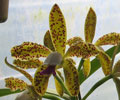|
|
|
|
|
| |
Flasks of
Cattleya guttata 'MC2481' × self |
|
| |
|
|
| |
|
|
Click to Enlarge

Pod Parent Flowers |
|
|
|
| |
Culture Notes from Donor: Parent plant: Temperature range CI (58-75°F)
Comments: From Troy: There is general disagreement about the varieties of C. guttata. Some would split them into different species (var. leopoldii as Cattleya tigrina, and var. prinzii as C. amethystoglossa) but others don't agree. Since this isn't settled, I'm not excluding this as a hybrid.
Parent plant: The plant is the offspring of 'Leopoldii' x 'Prinzii'. Tall bifoliate, easy to bloom, fragrant.
For additional origin/habitat information supplied courtesy of
Charles and Margaret Baker, see further below, near the bottom of this page.
|
Temperatures we attempt to use in the lab & greenhouse:
| For Species: |
|
Spring, Summer, Autumn: days average 85°F, nights 68°F; best fit is Warm-Intermediate 87-64°F
(Source:
Baker's Web OSC) |
| For Species: |
|
Winter: days average 77°F, nights 58°F; best fit is Cool-Intermediate 75-58°F
(Source:
Baker's Web OSC) |
| For Genus: |
|
Spring, Summer, Autumn, Winter: days average 83°F, nights 60°F; best fit is Intermediate 83-60°F
(
) |
|
About the name...
| Etymology of |
Cattleya |
|
Named in honor of William Cattley, English horticulturist in the 19th century.
(Source:
Pridgeon 1992) |
| Etymology of |
guttata |
|
From Latin "guttatus" spotted.
(Source:
Mayr & Schmucker 1998) |
| Pronunciation of |
Cattleya |
|
KAT-lee-ya
(Sources:
Pridgeon 1992, Hawkes 1978) |
| Pronunciation of |
guttata |
|
goo-TAH-ta
(Source:
Hawkes 1978) |
|
If you would like to direct someone to this web page, please copy and paste this URL into your email:
http://troymeyers.com/d?014209
| Flask Information |
| Availability: |
We have sold all of the flasks for this item. |
| You should: |
Consider getting individual plants or compots instead of a flask.
You can place a "Notify Flask Recipients" Request, and either we or a flask recipient may contact you when plants are available.
You may also place a "Notify Retries" Request, and if an identical pollination (the same parents) is done again, we'll let you know.
You may reserve a flask, but it's very unlikely you'll get one ...this could only happen if we found a flask that we didn't know we had. |
| Yield Estimate: |
620 plants (based on flask surveys done 05/26/2004 through 10/20/2006)
|
| Plantlet Sizes: |
From many flasks 3 - 60 mm plants (based on flask surveys done 08/20/2004 through 05/18/2007)
From one most recently surveyed flask 30 - 50 mm (05/18/2007)
|
|
You might also want to:
|
View the seed assay for this item.
View items of the same species.
View items of the same genus.
|
| Ordering Information |
| You are not currently logged in. |
|
You must be a registered user and be logged in to reserve a flask or place a notification request. Please log in:
|
|
|
|
|
|
| |
The origin/habitat information below is supplied courtesy of Charles and Margaret Baker
The following information is based on the name of the plant provided by the donor, and assumes that the name is correct. If the plant has been misidentified, then the following information may not be correct.
This text is copyrighted by the Bakers and may not be reproduced without permission.
ORIGIN/HABITAT: Coastal Brazil. The habitat extends from near Guarapari in
Espírito Santo to near Paranagua in Paraná. In Espírito Santo, plants are
found from sea level along the coast to 2000 ft. (0-610 m) along rivers as
far as 75 mi. (120 km) inland. In the states of Rio de Janeiro and São
Paulo, plants are usually found below 600 ft. (180 m) along rivers or in
swampy forests. They usually grow 30-60 ft. (9-18 m) above the ground on
the horizontal branches of large old trees which overhang streams or
swampy areas. The trees on which the orchids grow are usually covered with
vines, bromeliads, and other epiphytes. Growing near water and among other
plants helps keep humidity high during the dry season. In some areas of
Espírito Santo, plants grow on northeast-facing cliffs on lichen covered
rocks and on the exposed roots of dwarf trees.
More about this information and the Bakers...
|
|
|
| |
|
|
|